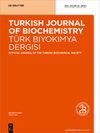Regulation of mitogen activated protein kinases through heterotrimeric G proteins
IF 0.7
4区 生物学
Q4 BIOCHEMISTRY & MOLECULAR BIOLOGY
Turkish Journal of Biochemistry-turk Biyokimya Dergisi
Pub Date : 2013-01-01
DOI:10.5505/TJB.2013.62534
引用次数: 0
Abstract
Heterotrimeric G proteins are known as G proteins, consist of α, β, and γ subunits. G protein mediated signaling is employed by virtually all cells in the mammalian organism and is centrally involved in diverse physiological functions such as perception of sensory information, modulation of synaptic transmission, hormone release and actions, regulation of cell contraction and migration, or cell growth and differentiation. The amino acid identity of the α subunits has been used as basis for the classification of G proteins into four families Gs, Gi, Gq, and G12. G proteins stimulate distinct downstream effectors including enzymes, ion channels and small GTPase, thus regulating multiple signaling pathways including those involved in the activation of mitogen-activated protein kinase pathways. Mitogen-activated protein kinases are a family that constitute signaling pathways involved in processes that control gene expression, cell division, cell survival, apoptosis, metabolism, differentiation and motility. The mitogen-activated protein kinase family includes ERK1/2, c-Jun N-terminal kinazlar 1, 2 ve 3, p38MAPK a, b, g, and d, and ERK5 as classical mitogen-activated protein kinases, and ERK3, ERK4 NLK, and ERK7 as atypical mitogen-activated protein kinases. Each of mitogen-activated protein kinase pathways consists of three distinct kinases, namely an upstream respectively; mitogen-activated protein kinase kinase kinase , mitogen-activated protein kinase kinase and mitogen-activated protein kinase异源三聚体G蛋白调控丝裂原活化蛋白激酶
异三聚体G蛋白被称为G蛋白,由α、β和γ亚基组成。哺乳动物中几乎所有细胞都使用G蛋白介导的信号传导,并主要参与多种生理功能,如感觉信息的感知、突触传递的调节、激素的释放和作用、细胞收缩和迁移的调节、细胞生长和分化。α亚基的氨基酸特性已被用作G蛋白分为G、Gi、Gq和G12四个家族的基础。G蛋白刺激不同的下游效应物,包括酶、离子通道和小GTPase,从而调节多种信号通路,包括参与丝裂原活化蛋白激酶通路的激活。丝裂原活化蛋白激酶是一个家族,它构成了参与控制基因表达、细胞分裂、细胞存活、细胞凋亡、代谢、分化和运动过程的信号通路。丝裂原活化蛋白激酶家族包括ERK1/2、c-Jun n端kinazlar 1、2、3、p38MAPK a、b、g、d和ERK5,它们是典型的丝裂原活化蛋白激酶,ERK3、ERK4 NLK和ERK7是非典型的丝裂原活化蛋白激酶。每一个丝裂原激活的蛋白激酶途径由三个不同的激酶组成,分别是上游激酶;丝裂原活化蛋白激酶,丝裂原活化蛋白激酶和丝裂原活化蛋白激酶
本文章由计算机程序翻译,如有差异,请以英文原文为准。
求助全文
约1分钟内获得全文
求助全文
来源期刊
CiteScore
1.20
自引率
0.00%
发文量
0
审稿时长
6-12 weeks
期刊介绍:
Turkish Journal of Biochemistry (TJB), official journal of Turkish Biochemical Society, is issued electronically every 2 months. The main aim of the journal is to support the research and publishing culture by ensuring that every published manuscript has an added value and thus providing international acceptance of the “readability” of the manuscripts published in the journal.

 求助内容:
求助内容: 应助结果提醒方式:
应助结果提醒方式:


